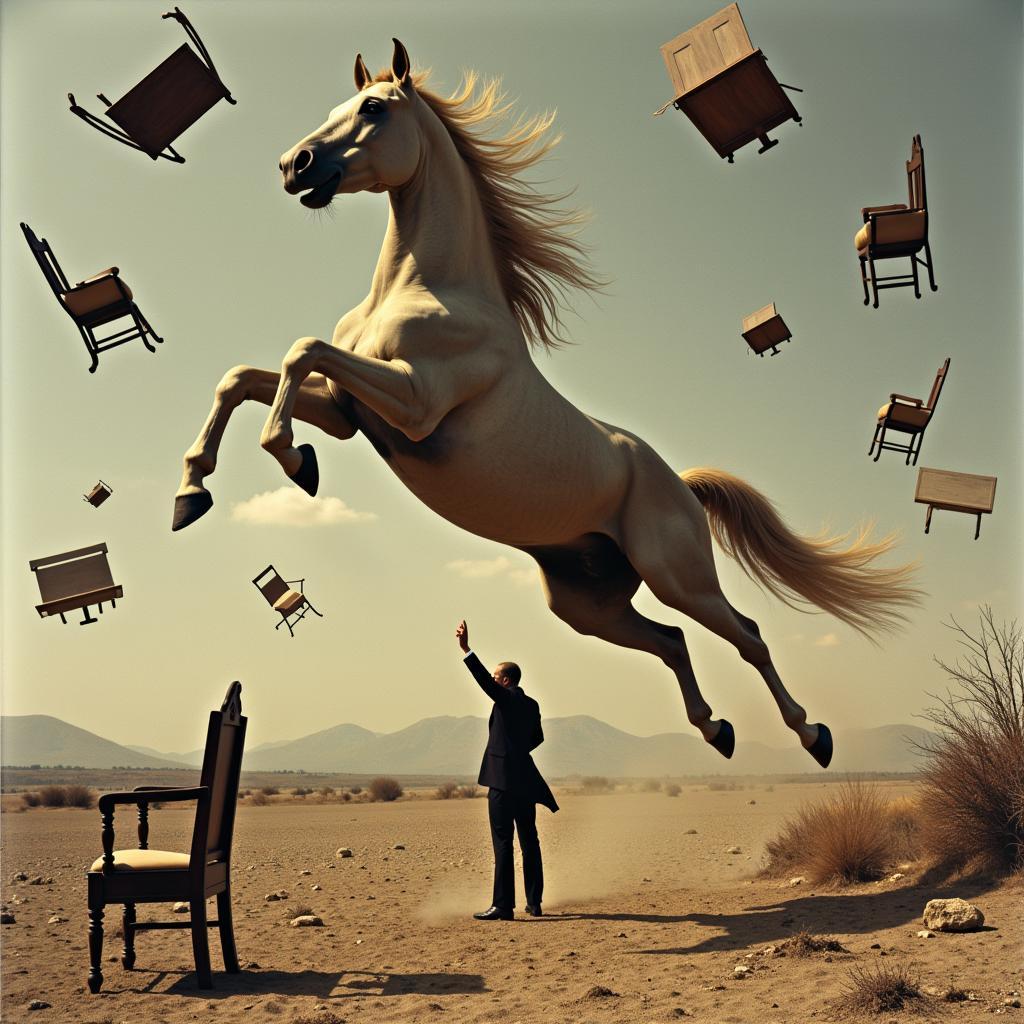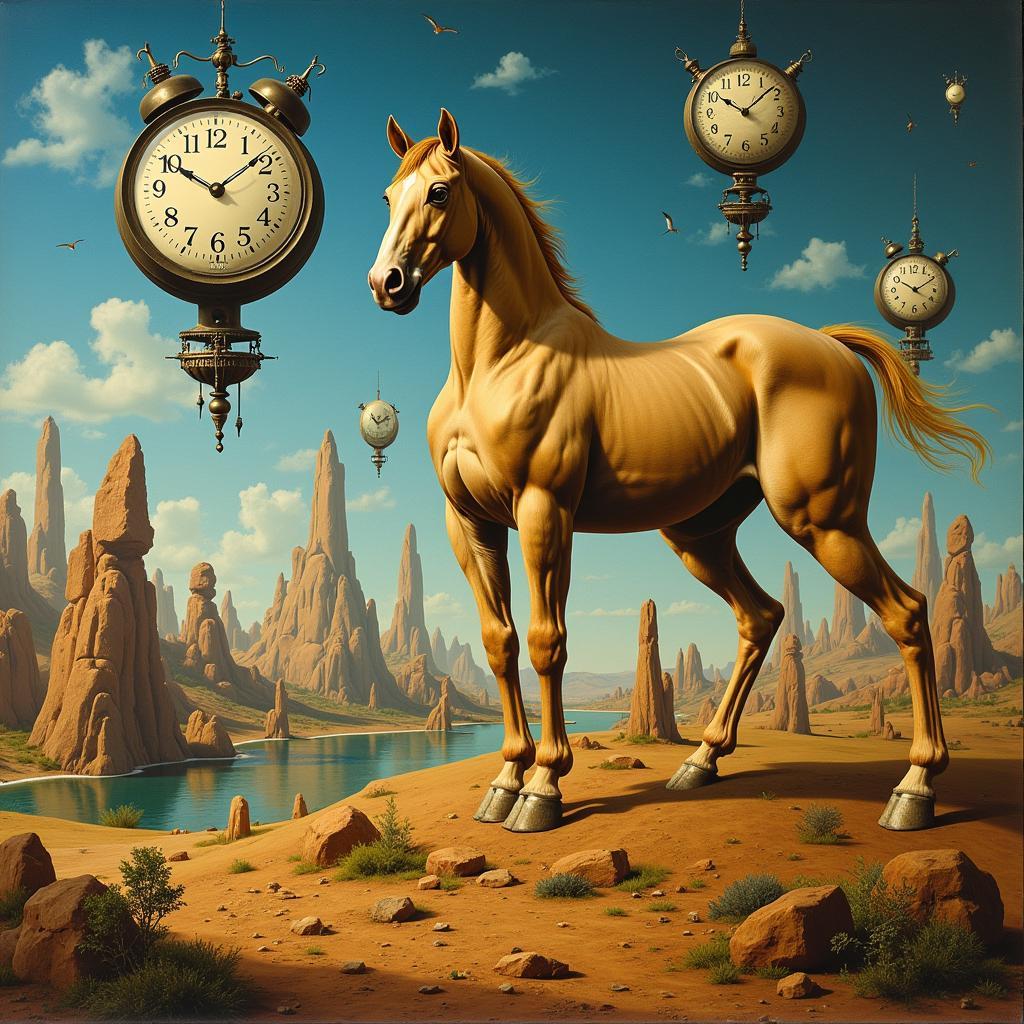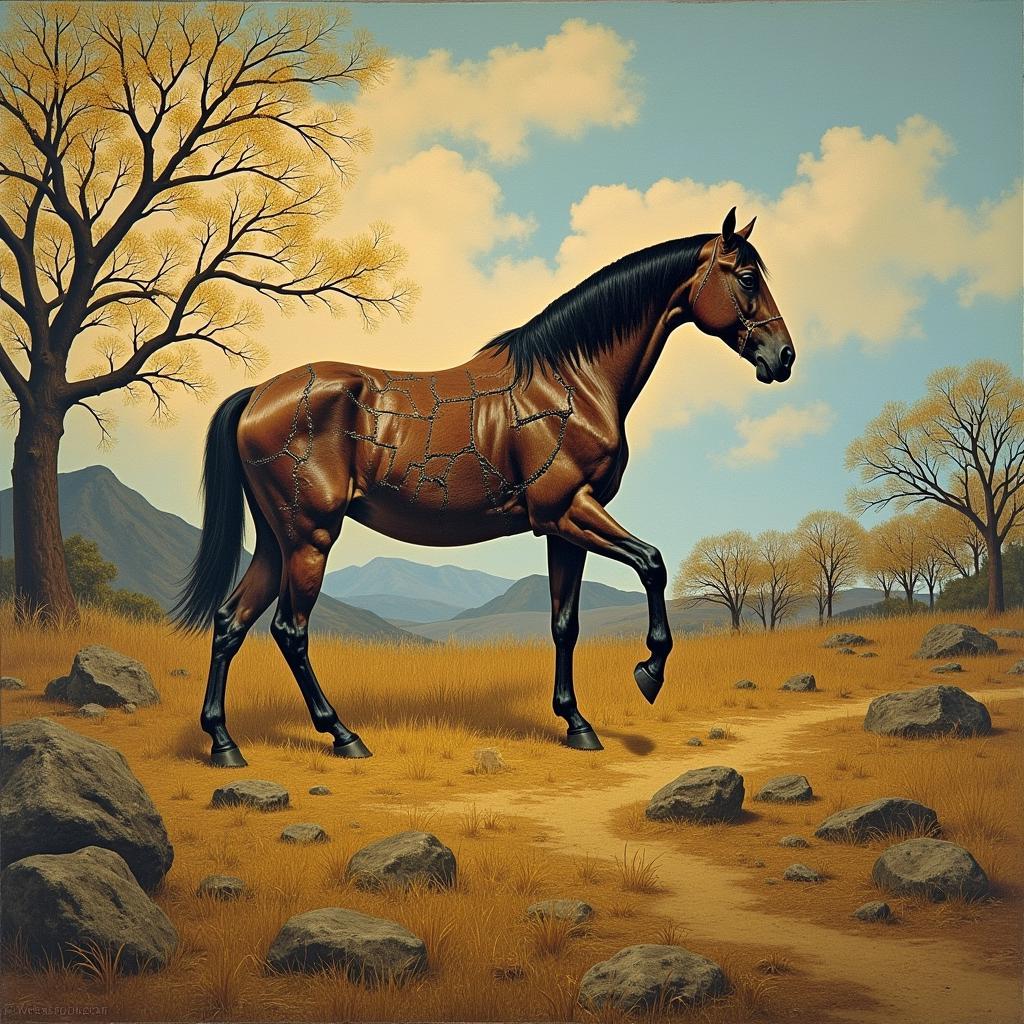Salvador Dali Paintings Horse: a captivating intersection of surrealism and equestrian imagery. Dali, the master of the unexpected, often incorporated horses into his dreamlike canvases, imbuing them with symbolic meaning and adding a layer of mystique to his already enigmatic artwork. This article explores the recurring motif of horses in Dali’s work, examining their symbolic significance and the artistic techniques he employed to bring these powerful creatures to life on canvas. salvador dali horse
The Horse as a Symbol in Dali’s Surreal World
Horses appear in various forms throughout Dali’s oeuvre, from graceful steeds to distorted, almost nightmarish figures. They often symbolize power, freedom, and virility, but their meaning can shift depending on the specific context of the painting. Sometimes they represent repressed desires, other times they embody the untamed forces of nature. The artist’s personal experiences and the cultural context of his time also influenced his portrayal of these majestic animals. Understanding these factors allows us to delve deeper into the complex symbolism within Dali’s art. What exactly did the horse represent to Dali? That question, like much of his work, remains open to interpretation, sparking continuous debate and fascinating discussion among art enthusiasts.
Unraveling the Mystery of Dali’s Equestrian Imagery
Dali’s fascination with horses likely stemmed from his childhood in rural Spain, where horses were a common sight. This early exposure undoubtedly left a lasting impression on the young artist. His later exploration of Freudian psychoanalysis likely further shaped his artistic vision, leading him to associate horses with primal instincts and subconscious desires. Dali also drew inspiration from classical mythology and religious iconography, further enriching the symbolism of the horse in his work.
 Atomicus by Salvador Dali featuring a horse leaping through the air
Atomicus by Salvador Dali featuring a horse leaping through the air
Dali’s Artistic Techniques: Bringing Horses to Life
Beyond the symbolic meaning, Dali’s artistic skill is evident in the way he renders horses. He masterfully employed techniques like meticulous detail, exaggerated proportions, and the juxtaposition of contrasting elements to create a sense of both realism and dreamlike unreality. He often distorted the horse’s form, elongating limbs or twisting their bodies into impossible positions, further emphasizing the surreal nature of his paintings. These distortions weren’t random; they served to heighten the emotional impact of the piece, evoking a range of responses from awe to unease. How did Dali manage to capture such dynamic movement and emotional intensity in his portrayal of horses? His mastery of light, shadow, and perspective allowed him to create images that were both visually stunning and deeply unsettling.
The Influence of Surrealism on Dali’s Horses
Surrealism, a movement that sought to liberate the unconscious mind, provided the perfect framework for Dali’s exploration of equestrian themes. The movement’s emphasis on dreams, symbolism, and the irrational allowed Dali to depict horses in ways that defied conventional representation. He freed himself from the constraints of realism, transforming horses into fantastical creatures that inhabit a world of dreams and illusions. salvador dali horse
 A surreal landscape with a distorted horse figure in the foreground, reflecting the dreamlike quality of Dali's work
A surreal landscape with a distorted horse figure in the foreground, reflecting the dreamlike quality of Dali's work
Famous Dali Paintings Featuring Horses
Several of Dali’s most iconic works feature horses. “Atomicus” captures a horse in mid-air, frozen in a moment of suspended animation, while other paintings, such as those in his “invisible horse” series, challenge the viewer’s perception of reality by partially obscuring the horse’s form. Each painting offers a unique glimpse into Dali’s artistic vision and his fascination with these powerful creatures. Examining these works provides valuable insight into the evolution of Dali’s artistic style and the enduring power of the horse as a symbol in art. Dr. Elena Ramirez, art historian and Dali scholar, notes, “Dali’s horses are not merely representations of animals; they are symbolic vehicles that transport the viewer into the depths of the artist’s subconscious.”
 An example of Dali's "invisible horse" series, where the horse's form is partially obscured, challenging the viewer's perception
An example of Dali's "invisible horse" series, where the horse's form is partially obscured, challenging the viewer's perception
Conclusion: The Enduring Legacy of Dali’s Equestrian Art
Salvador Dali paintings horse continue to captivate audiences worldwide. His unique portrayal of these animals, infused with surrealism and symbolic depth, has solidified their place in art history. By understanding the context, symbolism, and artistic techniques employed by Dali, we can gain a deeper appreciation for the enduring power and mystique of his equestrian imagery. Exploring Dali’s work invites us to question our perceptions of reality and to embrace the boundless possibilities of the human imagination.
FAQ
-
What do horses symbolize in Dali’s paintings? Horses often represent power, freedom, and virility, but their meaning can shift based on the specific painting.
-
Which Dali painting famously features a leaping horse? The photograph “Atomicus” captures a horse in mid-air.
-
What is the “invisible horse” series? This series features paintings where the horse’s form is partially obscured, challenging the viewer’s perception.
-
How did Surrealism influence Dali’s depiction of horses? Surrealism allowed Dali to depict horses in ways that defied conventional representation, transforming them into fantastical creatures.
-
Where can I see Dali’s horse paintings? Many of Dali’s works are housed in museums around the world.
Common Questions About Salvador Dali’s Horse Paintings:
- Why are the horses often distorted in Dali’s paintings? Dali used distortion to reflect the dreamlike, surreal nature of his work and explore the subconscious mind.
- Did Dali have a personal connection to horses? His childhood in rural Spain likely contributed to his fascination with horses.
- Are there any recurring themes related to horses in Dali’s work? Themes of power, freedom, and the subconscious often appear in his equestrian-themed pieces.
Further Exploration:
Explore more of Dali’s fascinating world by reading about his other recurring motifs and symbolic imagery. Discover the stories behind his most famous works and delve deeper into the world of Surrealism.
Need support? Contact us at Phone Number: 0772127271, Email: [email protected] or visit us at QGM2+WX2, Vị Trung, Vị Thuỷ, Hậu Giang, Vietnam. We have a 24/7 customer service team.